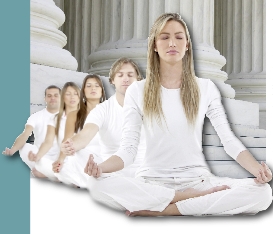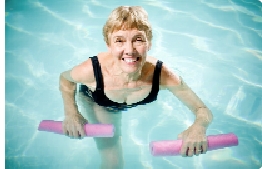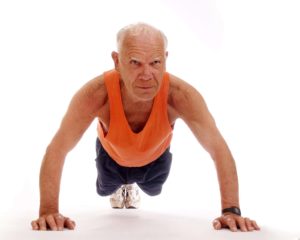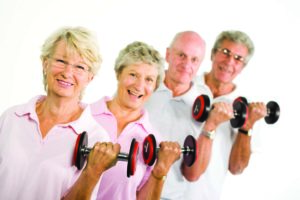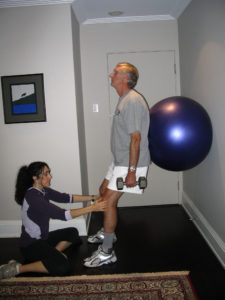Functional Aging/Older Adults
Leg Strength = Independent Living for Older Adults
Older adults who wish to remain physically independent should improve leg strength, advised researchers from Wake Forest University and Wake Forest University Baptist Medical Center. The recommendation was based on two studies performed by the same group. The first study evaluated physical function in 230 retirement community–dwelling adults. Many of these residents were found to have lower-limb strength deficits, and the researchers were concerned that these deficits might negatively affect mobility.
Blood Flow a Key to Older-Adult Balance
Incorporating balance techniques into older-adult training programs is often a go-to method for reducing falls. Recent research suggests that a focus on improving blood pressure may also be necessary to keep older adults safe. The study was published in the May 18 issue of Neurology (2010; 74, 1627–33).
Pilates Practice Improves Balance and Autonomy for Older Women
Practicing equipment-based Pilates twice weekly helps older women improve static balance and functional independence, according to a small study published in the Journal of Bodywork and Movement Therapies (2010; 14,…
dietary protein may reduce hip fractures in the elderly
A hip fracture can devastate the life of older adults and their families. Seniors lose their independence, suffer terrible pain and in many cases never regain their quality of life postinjury. However, some encouraging research has emerged that has the potential to lower the incidence of hip fractures in the elderly.
Mayo Clinic Coins New Term: Boomeritis
More and more Baby Boomers are engaging in regular physical activity. However, improved fitness levels may come at a painful price. According to the March issue of the Mayo Clinic Women’s HealthSource, an increasing number of people aged 50–60 are suffering exercise-related injuries. This rash of injuries has given rise to a new term, boomeritis, coined by the Mayo Clinic. The most common injuries associated with boomeritis include tendonitis, bursitis, stress fractures and tendon tears.
got grape juice?
Older adults suffering from mild cognitive impairment may be able to enhance their ability to function by drinking more Concord grape juice, according to a study published in the December…
Tai Chi Improves Sleep for Older Adults
Regular tai chi practice may improve the quality of sleep and, consequently, the quality of life for older adults. Lack of sleep or poor-quality sleep is a persistent issue for…
Older Adults Enjoy Tai Chi and Aquatic Exercise
The most popular exercise activities for adults aged 65 or older include tai chi and aquatic exercise, according to Tracking the Fitness Movement (2009 edition), a report released by the Sporting Goods Manufacturers Association (SGMA). Even though the fitness industry has been impacted by the economy, and sales of fitness equipment have taken a hit, the SGMA study shows that interest and participation in fitness activities by older adults remain very strong.
Tai Chi May Help Older Adults Improve Proprioception
Practicing tai chi helps older adults maintain their balance when their eyes are closed, according to a small study published in the Archives of Physical Medicine and Rehabilitation (2010; 91…
Cognitive Improvements and Exercise
People who experience cognitive impairments should be encouraged to engage
in regular cardiovascular activity, says
a recent study. Published in the January
issue of Archives of Neurology (2010; 67 [1], 71–79), the study sought to discover whether regular exercise could have a beneficial effect on mild cognitive impairment.
According to the Mayo Clinic website, mild cognitive impairment affects about 20% of the population over 70.
Lessons From the Blue Zones
Is there a formula for longevity? Researchers are looking for clues in the “blue zones,” locations around the globe where people live measurably longer than in the rest of the world. Dan Buettner, explorer and author of the best-selling book The Blue Zones: Lessons for Living Longer From the People Who’ve Lived the Longest (National Geographic 2008), believes that the blue zones have much to teach us about how to live longer, better lives.
The Truth About Bioidentical Hormones
Many of your Baby Boomer female clients or class members may be taking—or thinking about taking—bioidentical hormones. Fantastic claims are often made about these supposedly “natural” hormones. Not only are they said to relieve the symptoms of menopause, but they are often purported to cure a host of diseases and even to increase longevity (Boothby & Doering 2008).
Age = Decreased Fitness Levels
Research from the University of Houston has shown that men and women become less physically fit with age and, crucially, that their lifestyle influences their fitness level. The 32-year study of more than 20,000 men and women aged 20–96 was published in the October 26 issue of Archives of Internal Medicine (2009; 169 [19], 1781–87). During the intervention, participants completed between two and 33 health examinations, which included nutrition, exercise and lifestyle education and a maximal Balke treadmill test.
Muscle Strength Associated With Lower Risk of Alzheimer’s
More muscle strength is associated with a reduced risk of Alzheimer’s disease and cognitive decline, according to a study published in the Archives of Neurology (2009; 66 [11], 1139–44). Researchers from Rush University Medical Center in Chicago, Illinois, studied more than 900 residents of retirement communities in the Chicago area who had no dementia at the beginning of the study. The scientists measured strength in nine muscle groups and then compared results with strength measurements and cognitive function approximately 31/2 years later.
The Big Three Can’t-Miss Exercises for Seniors
Before you teach your older-adult classes a core routine, remember that in order to maintain stability and support, the core is activated milliseconds before any movement occurs in the body, so don’t limit your thinking of core exercises to the abdominals or lower back. Even small movements in the periphery of the body are sufficient to recruit and condition the core musculature. Also, recognize that a lean and sculpted core is generally not a requirement for older adults’ quality of life.
Working May Enhance Retirees’ Health
Engaging in bridge employment—
defined as part-time, temporary or self-employment—as a transition to permanent retirement may enhance the health of older adults, according to a study published in the Journal of Occupational Health Psychology (2009; 14 [4], 374–89). Data analysis from 12,189 retirees
enrolled in the Health and Retirement Study formed the basis for this finding.
What’s Good for the Body Is Good for the Brain
Have you ever walked into a room and forgotten why you were there? Diminished cognitive health—from this type of mild decline to more serious dementia—can have profound implications for overall health and well-being. Sustained brain health and enhanced lifelong learning are vital parts of aging and improve quality of life. Cognition, which includes mental processes such as intuition, judgment, language, remembering and the ability to learn new things, has a key role in wellness.
Senior Fitness Research Roundup
According to the Centers for Disease Control and Prevention (CDC 2009), by 2030 the portion of the U.S. population aged 65 and older will double to about 71 million. The growing number of older Americans will put unique demands on public health, aging services and the nation’s healthcare system. The CDC suggests that chronic diseases (e.g., cardiovascular disease, stroke, cancer and diabetes) place a profound health and economic burden on older adults, owing to associated long-term illness, diminished quality of life and greater healthcare costs.
High-Impact Sports Beneficial for Older Adults?
As the body ages, it is vitally important to maintain bone health through weight-bearing activity. According to a recent report, higher-impact physical activity may be beneficial for improving bone strength. Published in the November/
December issue of Sports Health: A Multidisciplinary Approach (2009; 1 [6], 508–13), the report suggests that bone mineral density (BMD) can increase significantly in older athletes who participate in high-impact sports.
Sports Training for the Older-Adult Athlete
Client: Arnie
Personal Trainer: Jennifer L. Salter, MSW, owner of Lifeline Personal Training
Location: Toronto
